These changes will alter the composition of plant communities in semi-arid areas, where an accentuation of droughts is expected. The results of this research suggest that the vital rates of plant species are affected by the demographic behavior of other species with which they interact and coexist.
The study, developed by researchers from the Rey Juan Carlos University, the University of Valladolid and the University of Central Florida (United States), assesses the relationships between two species of small dominant shrubs from semi-arid areas over almost a decade. The researchers show that the vital rates of both species fluctuate according to the population variations of the other species and that these fluctuations depend on the climatic context of each year. They emphasize that this is the first time that the dynamics of a population has been modeled taking into account that of another species with which it coexists and indicates that variations over time allow the coexistence of both.
This study, led by Ana García-Cervigón, a URJC researcher, has been developed for 9 years in the vicinity of the Cuenca town of Belinchón. The study has analyzed the demographic variations of two species of small shrubs that grow on soils with a high content of gypsum. The results of this research, recently published in the scientific journal Scientific Reports, point out that the way in which plants interact with each other depends on the climate and that this interdependence could end up altering the future composition of plant communities. Thanks to this joint effort, the researchers have been able to study the population dynamics of the two species. “Working with this team has been key to recording, modeling and interpreting the enormous amount of data that we had. We have observed that, despite being well adapted to semi-arid conditions and gypsum soils, each species responded somewhat differently to a common climate scenario, which in turn conditioned the responses of the other species ”, says García -Cervigón.
Long-term follow-up allows recording extreme and infrequent events
Researchers have followed demographic populations of two small shrubs, Helianthemum squamatum and Lepidium subulatum , for 9 years. This tracking has involved periodic visits to the study area twice a year, in spring and late summer, to assess the survival, growth and reproduction of the plants. The person in charge of leading this monitoring has been José Miguel Olano, a researcher at the University of Valladolid. "The wet years germinated thousands of new plants of both species, which also survived the first summer very well, but there were other years in which not a single one germinated," says Olano.

|

|
Lepidium subulatum plants |
Helianthemum squamatum seedling |
The importance of this long-term follow-up is that researchers have had the opportunity to observe and record some extreme events that would otherwise have gone unnoticed. Thus, in the spring of 2010, the rate of recruitment of new individuals multiplied by 10 the figures of the previous years. "These pulses of massive recruitment of individuals are typical of ecosystems in arid and semi-arid zones and are what allow populations to recover," says Adrián Escudero, URJC researcher and co-author of the work.
Statistical models are key to predicting the effects of climate change
The authors of the work have applied advanced statistical models called Integral Projection Models to study the population dynamics of their two species. "These models help us to interpret the meaning of the data at a demographic level and, in addition, allow us to carry out simulations to try to predict how plants will evolve in the face of climate change," explains Pedro Quintana-Ascencio, co-author of the work and researcher at the University of Central Florida . The application of these models has allowed us to find out that while one of the species, the scale jarilla ( H. squamatum ), harms the population of the other species, especially in years with good weather, the reciprocal effect is practically non-existent.